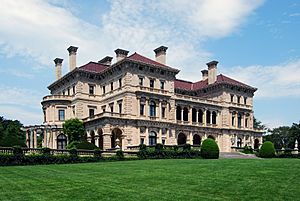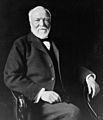Gilded Age facts for kids
The Gilded Age was an important period in the history of the USA. It started after the American Civil War ended. This era lasted until the late 19th century. It was a time of big changes in America.
The name "Gilded Age" was first used by the famous writer Mark Twain. He used it in his book The Gilded Age: A Tale of Today (1873). "Gilded" means something looks shiny and golden on the outside. But it might not be so great on the inside. This name suggests that while America looked rich and successful, there were also problems.
During this time, there was fast progress in technology. Railroads grew across the country. Industries also expanded very quickly. Millions of immigrants came to America seeking new lives. There were also many strong disagreements in politics. People argued about money, taxes on goods, and political corruption. They also debated about railroads and large businesses called trusts.
What Was the Gilded Age?
The Gilded Age was a period of rapid growth. It happened between 1865 and 1900. This was after the Civil War. The country changed a lot during these years. New inventions and industries appeared. Many people became very rich. But others struggled with poverty.
Why Was it Called "Gilded"?
The term "Gilded Age" came from a book. Mark Twain and Charles Dudley Warner wrote it. They used the word "gilded" to describe the era. Something "gilded" has a thin layer of gold on top. It looks valuable and shiny. But underneath, it might be made of a cheaper metal.
This name showed how many people felt about the time. America seemed very prosperous and modern. There were huge fortunes and grand buildings. Yet, there were also serious problems. These included poverty, unfair labor practices, and political corruption.
Big Changes and New Ideas
The Gilded Age brought many new things. Technology advanced quickly. New machines made factories more efficient. This led to a boom in manufacturing.
Railroads Connect the Nation
Railroads were a huge part of this era. New tracks were laid all over the country. This made it easier to transport goods. It also helped people travel. The First Transcontinental Railroad was finished in 1869. This connected the East and West coasts. It changed how people lived and worked.
Factories and Industry Grow
Industries like steel and oil grew very large. People like Andrew Carnegie (steel) and John D. Rockefeller (oil) built huge companies. These companies created many jobs. But they also sometimes had too much power. This led to concerns about monopolies.
Millions of Immigrants Arrive
Millions of people came to America. They came from Europe and other parts of the world. They were looking for new opportunities. Many worked in factories and mines. They helped build the growing nation. These immigrants brought new cultures and traditions.
Challenges of the Gilded Age
Even with all the growth, there were challenges. Not everyone shared in the wealth. Many workers faced tough conditions.
Workers' Rights and Struggles
Factory workers often worked long hours. They earned low wages. Their workplaces could be unsafe. This led to many strikes and protests. Workers wanted better pay and safer conditions. The Tompkins Square Riot in 1874 was one example. Police violently attacked unemployed workers.
Political Problems and Corruption
Politics during this time could be messy. There were often arguments over money and power. Some politicians used their positions for personal gain. This was called patronage or corruption. People wanted to reform the government. They wanted it to be fairer.
Debates Over Money and Taxes
There were big debates about money. Some people wanted "gold standard" money. This meant money was backed by gold. Others wanted more paper money. They thought it would help farmers and workers. Taxes on imported goods, called tariffs, were also a big topic. These taxes protected American businesses. But they also made some goods more expensive.
Images for kids
-
The celebration of the completion of the First Transcontinental Railroad, May 10, 1869
-
Toluca Street Oil Field in Los Angeles oil district, c. 1895–1901
-
Grand Central Depot in New York City, opened in 1871
-
Cornelius Vanderbilt versus James Fisk Jr. in a famous rivalry with the Erie Railroad
-
Oswego starch factory in Oswego, New York, 1876
-
Scottish immigrant Andrew Carnegie led the enormous expansion of the American steel industry
-
Octopus representing Standard Oil with tentacles wrapped around the U.S. Congress and state capitals, as well as the steel, copper, and shipping industries, and reaching for the White House
-
Cartoon showing Cyrus Field, Jay Gould, Cornelius Vanderbilt, and Russell Sage, seated on bags of "millions", on large heavy raft made of low wages and high prices being carried by workers
-
Businessman and politician P. J. Kennedy of Boston in 1900; his grandson John F. Kennedy became president in 1960
-
Temporary quarters for Volga Germans in central Kansas, 1875
-
Norwegian settlers in front of their sod house in North Dakota in 1898
-
The Home Insurance Building in Chicago became the world's first skyscraper when it was built in 1885
-
The Chess Players, Thomas Eakins (1876)
-
The Cup of Tea, Mary Cassatt (ca. 1879)
See also
 In Spanish: Gilded Age para niños
In Spanish: Gilded Age para niños





















